 |
||
|
||
| ||
Today we are reviewing AC'97-sound integrated into a motherboard. The board we have taken for this purpose is the D815EPFV from Intel. It is explained by an increased interest to integrated sound, which has been taking root more and more in a personal computer, thus forcing out cheap sound cards. But it doesn't want to stop and successfully competes against even expensive sound cards! Just look at the specs of the nForce APU. The NVIDIA engineers have succeeded to provide the characteristics of this sound system comparative to those of modern sound cards. But if a revolution lover - NVIDIA - has everything only on the paper and without mass production of certain models, Intel shows some heredity and chipset mutations. And if a couple of years ago, looking at mainboards with an integrated i810, we could only say that the sound was just provided, today the situation is much better. The functional power of the nForce APU is provided with several specialized DSPs. And Intel offers a program AC'97 based solution which doesn't yield to many HSP based entry-level sound solutions in specification. What is AC'97 soundToday this name is not very correct from the technical point of view but it is already a stable statement which means that sound corresponding to the AC'97 specification is integrated into a motherboard. Due to a scarce program support at the driver level this statement is often associated with something crippled on a software level. AC'97 is a concept which is not connected with a motherboard. It is a specification from Intel for an audio codec architecture (AC - Audio Codec) and digital interface AC-link, which connects this codec with Digital Controller. The latter can be realized in different ways: on a program level (only a bus controller is integrated into a chipset), on a soft hardware level (HSP, DSP), on a hardware one (DSP). In this case a controller or even the whole sound card are said to be implemented in the AC'97-standard (AC'97 compliant). The most of modern sound chips correspond to it: EMU10K1, CS46x0, FM801AU, YMF7x4, SSA7785, ES1970, AU88x0 etc. (The specification also contains a description of DAC/ADC of the modem codec MC'97. But the modem manufacturers doesn't feel a strong desire for hardware support of this specification together with a great deal of AMR/CNR/ACR-slots.) At the same time, I can't say that mainstream chips which do not correspond to the AC'97 specification are of low quality. I can say only that in case of integrated chips (EMU8K1, ES18XX, CM8738) in ISA-solutions nobody guarantee high quality and functionality required today. So, what can we get from a mainboard with a high-integrated chipset such as i815 which has integrated sound? Let's look at the scheme of "AC'97-sound" integrated into a chipset:  Instead of loading a CPU with operations with audio streams just partially, as it takes place in not expensive HSP-solutions (YMF7x4, FM801AU), in case of the "AC'97-sound" a central processor implements the function of a digital controller on the driver level completely! And an ICH (ICH - I/O Controller Hub) integrated into a chip of a motherboard by means of an AC-link bus controller controls data exchange with an AC'97-audio codec on a hardware level. So, instead of a bit strange term "AC'97-sound" it would be more correct to say "AC'97 codec based integrated sound with a program digital controller", or just "integrated sound". But all these peculiarities are not necessary for an ordinary user to know. It is enough to install drivers and you can apply to the integrated sound as to a usual sound card. But you should know what advantages and disadvantages such sound solution has. Integrated sound - who need it?The advantages are clear: a low price, scalability and an update only at the expense of driver replacement. Disadvantages are a possible performance decrease on weak systems and often poorer functionality. The latter means absence of multichannel analog and digital outputs on mainboards with integrated sound since they are positioned primarily as business and entry-level solutions, although potentially there is a good chance to realize a normal sound subsystem. Therefore, an issue of quality of sound processing on a program level becomes of vital importance. On the one hand, specialized DSPs with special mixing algorithms and real time effects are to some extent beyond comparison. On the other hand, as far as really high quality is concerned, on the top we have program solutions because DSPs of the same level are too expensive. Let's take, for example, professional 24/32-bit DirectX plug-ins. It is impossible to find fault with their quality and functionality, and a processor utilization corresponds to the appropriate level (one 48 KHz stereo stream processing in a real time mode on a processor of the P3-600 class takes only 10-15%). Why Intel promotes such a pure program solution is clear. A processor power is constantly growing. And in 3D games in middle and high resolutions a role of a CPU is not so noticeable - everything is limited by a video card or by incompetent programmers. A user has not so much reasons to buy newer and better processors. So why not to load an almost idle Pentium 4 with sound calculations? Besides, it is possible to press Low-End sound card manufacturers. But in practice, they gain at the expense of a better functionality. At $30 one can buy today a 6-channel sound card (on the FM801AU) with digital inputs and outputs, a built-in radio, with support of all modern sound 3D APIs and with a soft DVD-player. So, till recently integrated sound outscored in all parameters only old ISA-solutions and met only the minimal requirements of a modern computer (ICQ sounding, CD-DA and mp3 playback), i.e. only business requirements. But times change. Sound subsystem of the Intel D815EPFV mainboard The Intel's board on the i815E chipset is not an outstanding solution, but it offers quite interesting sound possibilities. Hardware:Integrated AC-link controller in the Intel 82801BA I/O Controller Hub (ICH2), with AMR and CNR support; 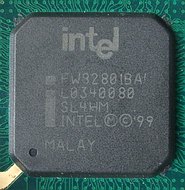 Stereo AC'97-audio codec Analog Devices AD1885; 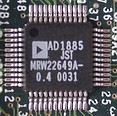  The board has plastic connectors with a color marking of PC99 (mic-in, line-out, line-in), and two internal connectors - AUX in, CD in and an unsoldered connector marked as "front panel audio connector (optional)". It is intended for connection of a bracket with a mic in and out to headphones;  Software:SoundMAX with SPX software from Analog Devices with the driver distributive weighing 54 MB(!). Optimization for MMX and SSE2 SIMD instructions for Intel Pentium III and Pentium 4 is provided. Drivers:Win98 SE, WinME and Win2K. Game 3D Sound API compatibility:
Audio codec characteristics:
MIDI:
SPX - Sound Production eXtention - is a new generation audio rendering technology. Sound synthesis is controlled directly from games and multimedia applications. 3D-sound from Sensaura:
InstallationThe motherboard is supplied with drivers for Win98 SE, WinME and Win2K. The most interesting drivers of sound devices are implemented in the form of WDM-drivers. Test system configuration:
OS Win98SE 4.10.2222A, DirectX 8.0a An Intel's auto installer sets all necessary patches and reboots the computer automatically. But after all settings are done you will see only the SoundMAX v.2, despite the fact that the distributive of the latest version of the drivers SoundMAX3 is provided. So, we had to install the third version after a correct deletion of the second one: 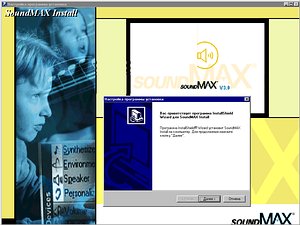 After rebooting the system tray acquires a blue icon of Analog Devices: 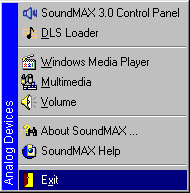 When choosing the upper item you will see a control panel with a great deal of settings of the SoundMAX 3.0:  For speakers there are three variants: headphones, close stereo speakers, and far stereo speakers. Sound media is where you should choose a sound environment. There are more than 10 presets. Virtual surround sound is a function of creation of virtual sources in headphones or speakers. By clicking the picture you will be taken to the Sensaura site into a virtual shop where you can buy this upgrade (only for the SoundMAX3!) or to load a 31-day trial-version. I have tried to do this (the picture is an animated gif, for viewing it activate this option in the browser): 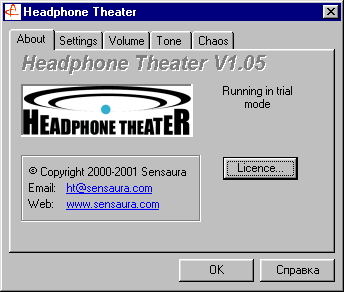 So, I have loaded my favorite player PowerDVD, set 6 channels, then activated a '2 speakers' mode in the control panel, as well as in the Headphone Theater. After that, during the composition playback with different multichannel tracks - Matrix, The Mask of Zorro, Blade - I conducted experiments with all variants of sound output through 2 speakers. And the Headphone Theater technology from Sensaura turned to be the best: first, the surround sound remains (if not positioning of sources), secondly, high frequencies are not cut off. When choosing the preset "headphones" there was some kind of virtualization of rear channels. At least, the sound was very interesting and much better than any "stereo base extensions" and Dolby Headphone. Besides, there are extended options for making settings for a virtual auditorium, where a movie is supposedly watched.  So, owners of stereo speakers who have this motherboard will get some additional trump with the Sensaura Headphone Theater technology, which will be free for a whole month. Another interesting and paid upgrade (without a trial version) is Virtual Ear technology. This technology allows for more than 3 standard presets for HRTF filters and for adjusting a 3D sound engine for your ears. 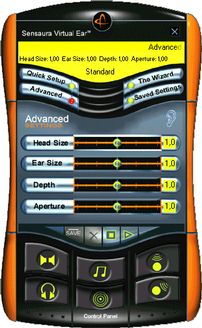 The next submenu also has a lot of settings: 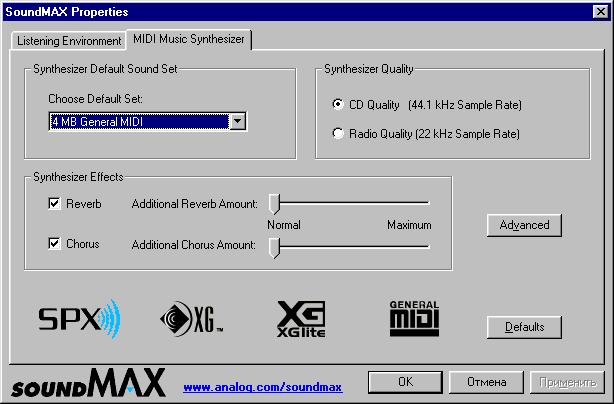 The Wavetable synthesizer 4 MBytes DLS2, 128 GM-instruments is provided. Besides, there is a special MIDI+DLS2 file loader: 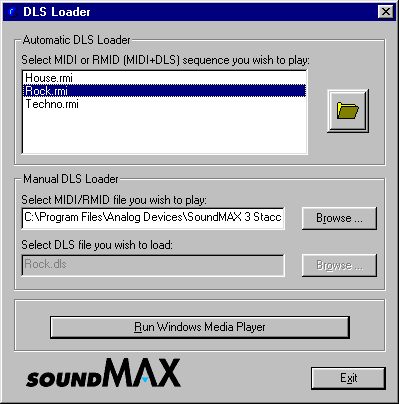 Above all, you will get three demo movies with specific tracker music. Why not? The DLS2 is an excellent format for user samples. 1024 MAXvoices refer to this synthesizer, and a standard 4 MBytes GM-bank is quite acceptable. At least, it is much better than a standard program Microsoft DirectMusic synthesizer with 3 MBytes of GS-samples Sound Canvas from Roland. As for 360 XGlite instruments of 1.2 MBytes, I liked them less. An attempt to play GM and XG compositions have revealed not very good and severely distorted (as compared with S-YXG50) instrument voices. If you prefer the XG MIDI, then you will probably have to install something from normal program synthesizers from Yamaha - 50th or 100th. Sample sounding was also tested on several karaoke files. Sometimes the 4 MBytes DLS2 GM-bank was better, sometimes the S-YXG50 excelled. The XGlite sounded blankly, and the quality of MIDI-channels' mixing was a bit dirty. But you might not notice it on a cheap acoustic system. Line-out testsThe AD1885 model is called by the manufacturer only as the AC'97 SoundMAX Codec. Among interesting peculiarities of this codec I should mark out the following: a multibit SD-converter architecture, a variable frequency of the AC-link bus (from 7 to 48 KHz in 1 KHz increments) and a direct connection of headphones without an external linear buffer. The tests were carried out according to a single for all sound cards technique. 1. Operation mode: 48000 Hz, 16 bits
Overall score: Good (in detail) 2. Operation mode: 44100 Hz, 16 bits
Overall score: Good (in detail) The AD1885 codec has shown perfect results for an integrated solution! A very low noise level. Harmonic distortions in the presence of a signal exceed the respective characteristics for many modern sound cards. The Realtek 8029 netcard located 1 cm away from the codec (an ideal noise supplier) hasn't affected the codec's characteristics. It should be noted that listening to the MP3 and CD-DA discs have left only pleasant impressions yet before the tests. Where is the SPX?Let's go to the official site at http://www.analogdevices.com/soundmax.  According to the link to the technical details we have found some examples of usage of this technology:
So, the SPX technology can modulate complex and dynamic sound images, where a usual sampler technology is weak. The companies which are already developing games with SPX support are Sony Online Entertainment (PlanetSide), Moto 1 (NHRA Drag Racing 2) and Infogrames (Test Drive). Tests in gamesThe Sensaura algorithms on which the game possibilities of the SoundMAX are based allow for very good quality of positioning and compatibility with a wide range of game 3D Sound APIs: DirectSound/ DirectSound 3D (DirectX 8.0), EAX 1.0/2.0, A3D 1.0, Sensaura Macro FX / ZoomFX, IA-SIG I3DL2. The A3D 1.0 has only partial compatibility with this interface by means of translation of some its calls into the DS3D. Moreover, we can install A2D 2.0 drivers on any sound card and have sound conditionally combined even with the A3D 2.0. The EAX 2.0 is, however, fully supported. I checked it in DeusEX (UT engine), Hitman: Codename47, Gunman Chronicles (HL engine), Serious Sam games. The positioning of sources was present, the sound was decent and didn't fall out even on such a weak computer as P3-550/128/GF2MX. The presets of EAX environment were switched on in all required cases. It was impossible to guess that it was sound integrated into a mainboard! The latter game Serious Sam has means for measuring the system performance. Let's see whether the program solution is worth manufacturing. We conducted measurements the following way. We called the console and typed dem_bProfile=1 <Enter>. Then we started the first demo from the menu - Karnak demo. The game settings were set to Normal. We compared the SoundMAX sound with an expensive hardware solution based also on the Sensaura - Hercules Game Theater XP sound card (CS4630 audio chip). To avoid influence of similar dll's of the SoundMAX and Hercules, the program and hardware solutions were tested separately by installation of their drivers on a blank system (thank to the Norton Ghost program for a possibility to create an image-file and immediate recovery of a partition from it). The second sound was taken out from the slot or disabled in the BIOS. As a reference sound for the EAX we have taken the Live! 5.1 Player card from Creative Labs. And to reveal how much of the performance the sound takes we also conducted the tests 'No Sound'. The tests were carried out twice for each card, then we chose the best result. The stability of measurements is uppermost - a spread in values didn't exceed +/-0.1 fps. On the graphs, fps values correspond to the abscissa axis. The game gave a lot of results, out of which I have chosen the average and the lowest fps. 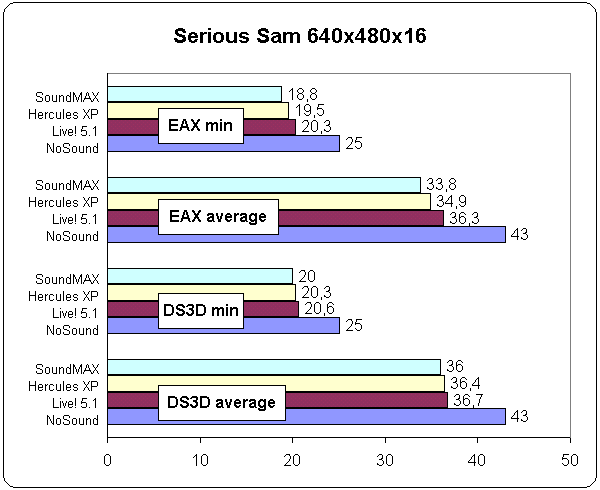 The first test in 16-bit color and at a low resolution shows just slight differences in the performance. The Live! is leading since it has the most powerful chip EMU10K. But the difference in a maximum of a couple of fps is impossible to notice during the hot game.  The second test was conducted at middle resolutions. The playability is not high due to a weak 550 MHz CPU. But the difference in middle frames per second is at the same level - 2..3 fps. Since the performance is mainly limited by the video card at middle and high resolutions, the CPU has enough time to process both soft and hardware sound. The differences between the 'NoSound' mode and the program sound are slight, and become even less distinguishable with an increase of resolution or the CPU performance. As for the quality of the sound, I haven't noticed any difference between the Hercules and the SoundMAX. The Live! 5.1 sounded just a bit better: there were more high frequencies, separate sounds were better heard in the general sound atmosphere. By the way, this demo tests very good the real quality of mixing of many sound streams - sources of the sound on a game scene. And there are at least 3 dozens of sounds there! :) Maybe the MIDI of the Live! is unclaimed, but it has algorithms of mixing of several tens of sound tracks in the excellent 32-bit quality without losses in sharpness and juiciness of sounding with the perfect reverberation... It is interesting whether someone one day will be able to win from the "king of sound Live!". On the other hand, I can't say that all those nuances and differences are critical. On cheap plastic speakers you might miss half of sounds, not counting finer details... And of course, for the integrated sound the shown quality is more than just good! It seems that Intel knowingly concluded an exclusive contract with Analog Devices for this technology till the end of the year. And what about the multichannel sound?we asked the Intel developers. They answered that to provide flexibility for OEM companies and to reduce initial expenses of buyers the mainboards will be equipped with only a stereo codec. And to extend the possibilities, be it 6-channel sound or a digital S/PDIF-output, there is a separate CNR extension card. We hope to fetch these sound CNR cards as soon as possible, and then we will tell you about all advantages and disadvantaes of such solutions in a separate article. ConclusionThe integrated sound SoundMAX with SPX from Intel and Analog Devices showed that one can make an excellent thing from a program solution, which won't yield to much more expensive hardware solutions either in functionality or in quality. Highs of the SoundMAX:
Lows of the SoundMAX:
Write a comment below. No registration needed!
|
Platform · Video · Multimedia · Mobile · Other || About us & Privacy policy · Twitter · Facebook Copyright © Byrds Research & Publishing, Ltd., 1997–2011. All rights reserved. |